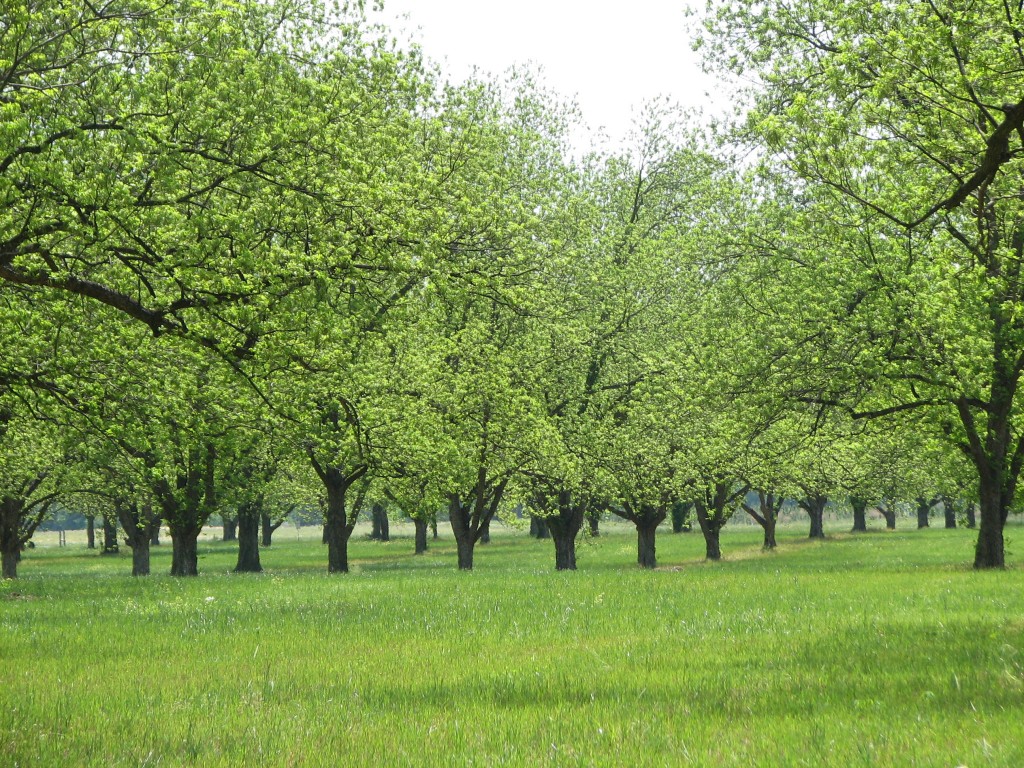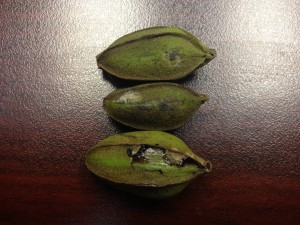Its the time of year when a few insects may rear their heads and cause some nut drop in the orchards. I refer here mostly to nut curculio and hickory shuckworm.
The nut curculio attacks immature pecans from late June through early August. Adults make shallow crescent shaped punctures with their snouts in the shucks of immature nuts in which they lay eggs. When the eggs hatch, the larvae consume the insides of the pecan. Adult feeding puncture are usually visible on damaged nuts. The curculio puncture and larval feeding within the pecan cause a bleeding brown sap (tobacco-like deposits) on the shuck of the nut at the point of entry and a premature nut drop similar to that caused by the hickory shuckworm. The damaged nuts drop from the tree, but the creamy-white legless larvae continue to feed in the dropped nuts for about two weeks before leaving the nut through a circular hole. The larvae form a pupal cell under the nut in the upper two to four inches of the soil. Adults emerge four weeks later and overwinter in ground trash or other protected places. This curculio produces only one generation per year. The most common treatment for curculio is chlorpyrifos but be sure you have a problem with them before you spray since chlorpyrifos will greatly aggrevate your aphid and mite situation.
When trees have a good nut crop, nut curculio damage may go unnoticed or be attributed to hickory shuckworm. Chemical control may be necessary when past history, jarring the trees, or knock-down sprays indicate the presence of many adults. Usually, trees adjacent to woods or thick hedge rows are more subject to nut curculio attack since these places provide overwintering sites for the adults.
Symptoms of nut damage by hickory shuckworm (top 2 nuts) and nut curculio (bottom nut)
Hickory shuckworm begins attacking when the nuts are first formed in early June and continues until harvest. Damage by the hickory shuckworm results from the feeding activity of the larvae. Prior to shell-hardening, the feeding of shuckworm larvae within the nut results in premature nut drop. After shell hardening, larvae are confined to feeding within the shuck. Damage resulting from the shuckmining activities of the larvae include poor kernel development (due to the severing of vascular tissue in the shuck), shuck sticking, scarring and discoloration of the shell and delayed nut maturity. Except for premature nut drop, shuckworm damage usually goes unnoticed unless the shuck is cut open to reveal the tunneling of the larva within the shuck.
Hickory shuckworm moths emerging in the spring, prior to nut formation, lay their eggs on pecan foliage, the galls of pecan phylloxera, and nuts of early developing hickories. Orchards with heavy phylloxera often end up with heavy shuckworm populations as well. Shuckworms hatching from eggs deposited on the foliage will generally die before completing their life cycle. However, those larvae developing within the phylloxera galls or hickory nuts are able to complete their life cycle, thus maintaining the population until nut formation occurs. Researchers have also reported that adult moths of the overwintering generation emerge from the shucks as late as July, August and September. During the summer months, female shuckworms begin to deposit their eggs on the nuts. After nut formation occurs, shuckworms populations usually increase with each succeeding generation. The number of generations per year will vary from two to five depending on location.
Currently, chemical control is the most widely used method for suppressing shuckworm populations. Contact insecticides like chlorpyrifos are directed at the adult moths, reducing the egg-laying population but flair aphids and mites. Insect growth regulators like Intrepid and Dimilin disrupt larval development, and must be applied before eggs are laid for the hatchling caterpillars to be exposed before entering the shuck.
Examine dropped nuts for the characteristic whitish residue around the entry hole in June and July. Orchards with a history of shuckworm problems should be treated at shell-hardening, as mature nuts will not drop. If late-season treatments are applied for pecan weevil control, they will also control hickory shuckworm.

